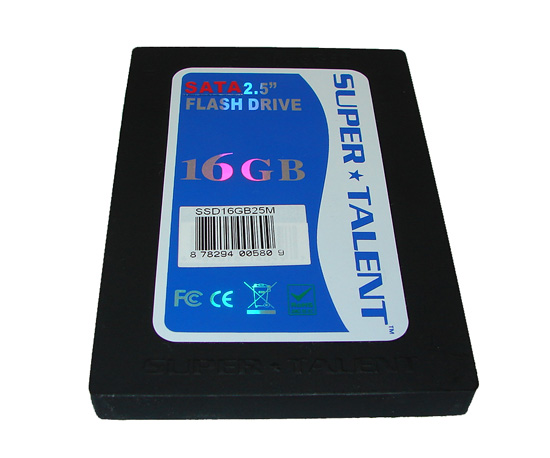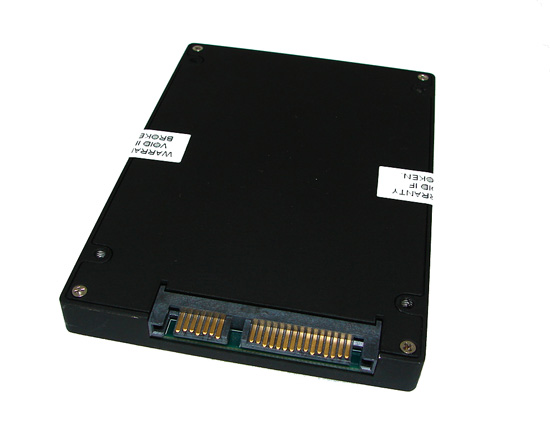Super Talent SSD: 16GB of Solid State Goodness
by Gary Key on May 7, 2007 4:00 AM EST- Posted in
- Storage
Super Talent SSD16GB25/25M Features


The external design of the Super Talent 16GB SSD is offered in either a hard plastic suitable for a commercial rating or high-strength aluminum design for industrial usage. The hard plastic design is capable of operating temperatures from 0C to 70C with the metal casing featuring a temperature range from -40C to 85C. The drive is based on the industry standard 2.5" form factor with measurements of 69.9mm x 100.2mm x 9.5mm. The drive utilizes a standard SATA interface for both power and data transfer capabilities.
Hard Disk Test Comparison and Features
The Super Talent SSD16GB25/25M features a capacity of 16GB with capacity in the 2.5" form factor family ranging from 4GB to 64GB. The 16GB drive sells for approximately $575 at this time. The drive is marketed into the commercial and industrial sectors with an emphasis placed on use in such products as ATM, factory automation machines, measuring products, point of sale devices, ticket-vending machines, parking systems, and general industrial equipment that requires a storage device with a high degree of tolerance to environmental conditions.
The SSD16GB25/25M features a read seek time of less than 1ms, a maximum read/write speed of up to 28 MB/sec, a sustained transfer rate of 25 MB/sec, and an estimated write/erase cycle of approximately 100,000 cycles. This equates into a 1,000,000 hour MTBF rating and indicates a 10 year life expectancy based upon normal usage patterns. Super Talent has developed a set of proprietary wear leveling algorithms along with built in EDD/EDC functions to ensure excellent data integrity over the course of the drive's lifespan.
Looking at the specifications, it should become immediately apparent that we should not expect class leading performance in all applications. The Super Talent drive has no cache, and the maximum read/write speeds are clearly lower than the best hard drives currently available. It's also worth noting that the relatively low read/write speeds and lack of cache make the question of SATA interface a moot point. While the drive can of course function with a chipset that supports SATA 3.0Gbps connections, it will only utilize the 1.5Gbps standard, and actual transfer rates are still significantly lower than the maximum 150 MB per second SATA is capable of transmitting.
The Super Talent drive is truly silent as indicated by the acoustics test, features a very low power envelope with load requirements being five times less than the Seagate Momentus drive, and excellent thermals considering our room temperature base was 24C. The drive is designed to withstand 1500G of shock and 16G of vibration under operating conditions.


The external design of the Super Talent 16GB SSD is offered in either a hard plastic suitable for a commercial rating or high-strength aluminum design for industrial usage. The hard plastic design is capable of operating temperatures from 0C to 70C with the metal casing featuring a temperature range from -40C to 85C. The drive is based on the industry standard 2.5" form factor with measurements of 69.9mm x 100.2mm x 9.5mm. The drive utilizes a standard SATA interface for both power and data transfer capabilities.
Hard Disk Test Comparison and Features
| Drive Specifications | |||
| Super Talent Flash Drive 16GB SSD16GB25/25M | Seagate Momentus 7200.2 160GB ST9160823ASG | Western Digital Raptor 150GB WD1500ADFD | |
| Manufacturer's Stated Capacity | 16 GB | 160 GB | 150 GB |
| Operating System Stated Capacity | 15.5 GB | 149.04 GB | 139.73 GB |
| Interface | SATA | SATA 3Gb/s | SATA 1.5Gb/s |
| Rotational Speed | n/a | 7,200 RPM | 10,000 RPM |
| Cache Size | n/a | 8 MB | 16 MB |
| Average Latency | n/a | 4.17 ms (nominal) | 2.99 ms (nominal) |
| Read Seek Time | 1 ms | 11 ms | 4.6 ms |
| Number of Heads | n/a | 4 | 4 |
| Number of Platters | n/a | 2 | 2 |
| Power Draw Idle / Load | .16W / .48W | .87W / 2.42W | 9.19W / 10.02W |
| Acoustics Idle / Load | 0 dB(A) / 0 dB(A) | 27 dB(A) / 32 dB(A) | 35 dB(A) / 48 dB(A) |
| Thermals Idle / Load | 24C / 25C | 27C / 31C | 47C / 58C |
| Write/Erase Cycles | 100,000 Estimated | - | - |
| Command Queuing | n/a | Native Command Queuing | Native Command Queuing |
| Warranty | OEM Specific | 5 Year - Retail or OEM | 5 Year - Retail or OEM |
The Super Talent SSD16GB25/25M features a capacity of 16GB with capacity in the 2.5" form factor family ranging from 4GB to 64GB. The 16GB drive sells for approximately $575 at this time. The drive is marketed into the commercial and industrial sectors with an emphasis placed on use in such products as ATM, factory automation machines, measuring products, point of sale devices, ticket-vending machines, parking systems, and general industrial equipment that requires a storage device with a high degree of tolerance to environmental conditions.
The SSD16GB25/25M features a read seek time of less than 1ms, a maximum read/write speed of up to 28 MB/sec, a sustained transfer rate of 25 MB/sec, and an estimated write/erase cycle of approximately 100,000 cycles. This equates into a 1,000,000 hour MTBF rating and indicates a 10 year life expectancy based upon normal usage patterns. Super Talent has developed a set of proprietary wear leveling algorithms along with built in EDD/EDC functions to ensure excellent data integrity over the course of the drive's lifespan.
Looking at the specifications, it should become immediately apparent that we should not expect class leading performance in all applications. The Super Talent drive has no cache, and the maximum read/write speeds are clearly lower than the best hard drives currently available. It's also worth noting that the relatively low read/write speeds and lack of cache make the question of SATA interface a moot point. While the drive can of course function with a chipset that supports SATA 3.0Gbps connections, it will only utilize the 1.5Gbps standard, and actual transfer rates are still significantly lower than the maximum 150 MB per second SATA is capable of transmitting.
The Super Talent drive is truly silent as indicated by the acoustics test, features a very low power envelope with load requirements being five times less than the Seagate Momentus drive, and excellent thermals considering our room temperature base was 24C. The drive is designed to withstand 1500G of shock and 16G of vibration under operating conditions.










44 Comments
View All Comments
JarredWalton - Monday, May 7, 2007 - link
The 100,000 writes is per sector (or whatever the flash block sizes are) of the drive, so even if you're generating thousands of writes per day if the writes are all going to different blocks it becomes much less of an issue. That's what the "proprietary wear leveling algorithms along with built in EDD/EDC functions to ensure excellent data integrity over the course of the drive's lifespan" are supposed to address.Unless you are intentionally rewriting a single location repeatedly, I don't doubt that the drives can last 10 years. Considering I have a lot of normal hard drives fail within five years, that's not too bad. Besides, with the rate of progress it's likely that in the future SSDs will get replaced every couple of years just like today's HDDs.
PandaBear - Thursday, May 10, 2007 - link
With wear leveling, it doesn't matter where you write, it is internally mapped to different physical location each time, so it is 100k write per sector x # of sectors = total # of write you can get out of the entire drive.In this case, a bigger drive buy you more than just space, it buys you extra blocks/sectors that it can cycle through and reduce the wear on every single drives.
Reflex - Monday, May 7, 2007 - link
[quote]That's what the "proprietary wear leveling algorithms along with built in EDD/EDC functions to ensure excellent data integrity over the course of the drive's lifespan" are supposed to address.[/quote]Just to address this specifically, there is no such thing as a 'standard wear leveling algorithm', every flash producer has thier own method of wear leveling, so by default they are all proprietary. I am relatively certain that this company has not come up with something so revolutionary that it would essentially change the entire market as you seem to be implying, if they have I am pretty certain these flash chips would be the industry standard by now. Furthermore, were it any more advanced than the competition, it would not be advertised with a 100k write limitation when the industry standard is 250k writes.
Reflex - Monday, May 7, 2007 - link
I am very aware of how it works. However write operations can happen across several sectors. Once again, consider the market these are intended for. You will NOT get ten years out of one on a typical workstation, it simply will not happen. You will get at least a decade out of one as part of a cash register, assembly line robot, or other industrial/embedded purpose, which is what their statement is all about.You are likely to get one to two years out of one of these, tops. Furthermore, when it fails it will be sudden, and you will not be able to recover your data through conventional means.
I highly suggest you test this before you reccomend your readers to use these things as a main drive. I have tested it extensively myself as part of my job. My email is in my profile if you feel the urge to contact me about this.